One day at work, Cathy Boyes wasn’t feeling well. Thinking she had symptoms of the flu, the 54-year-old executive assistant went down four floors to the wellness center at her office. Less than 30 minutes later, Boyes was diagnosed with a bad cold and left the wellness center with some prescription medicine to help with her congestion.
Boyes works at Aetna’s headquarters in Hartford, Connecticut, where the health insurance company has a pretty comprehensive health services center for its employees. There, workers can stop by for an exam with the company’s on-site physician without an appointment. There’s also a pharmacy that’s open during work hours where workers can fill prescriptions, both from the office’s health center as well as those from outside doctors.
Workers usually stop by Aetna’s wellness center, which opened in November 2008, with fairly simple injuries or ailments -- a sore throat or sprained ankle, for example. Sometimes, workers are sent to the emergency room if the on-site doctor thinks employees need more serious attention.

“The care was amazing,” Boyes told The Huffington Post. “It saved me a trip to the doctor’s office and it saved me time away from my job.”
A 2013 report from the Rand Corp. found that workplace wellness has become a $6 billion industry in the U.S., with about half of all large employers offering some type of a wellness program. One wellness initiative that's caught on among large employers is on-site health clinics, which experts say help companies control costs and address a growing demand for convenient, accessible care.

On-site clinics are a lot more common in very large companies than smaller ones, where it's harder to have a system that's cost-effective. Offering on-site medical care requires a large upfront capital investment, and it's often hard to convince a company's stakeholders that the investment will be worth it in the long-run, according to David Keyt, a consultant at Mercer who specializes in worksite clinics.
After all, Keyt said, containing costs is the main reason employers have on-site clinics. The other two main reasons are helping employees manage their health and any chronic conditions and increasing employee productivity.
Employers have run out of ways to contain health care costs, Keyt said, and on-site clinics offer a new strategy. The Affordable Care Act has also created a strain on the nation's health care system by increasing the number of people who are covered by insurance. On-site clinics guarantee workers access to the services that'll help keep them healthy and productive, he said.
The effectiveness of wellness programs is a hot topic of debate. Some argue wellness programs don't actually save all that much money and end up simply shifting some health care costs onto less healthy employees. And according to a recent Gallup survey, most workers think that their jobs are detrimental to their overall well-being.
That said, a 2010 Harvard study cited by the Centers for Disease Control and Prevention found that a company’s medical costs decrease by about $3.27 for every dollar spent on wellness programs. The same study found that absenteeism costs (i.e. the costs a company incurs when an employee can’t come to work) also decline by about $2.73 for every dollar spent.
Lou Nowikas, Hearst's vice president of real estate, said the media company's clinic has been "a huge success.”
At Hearst, it’s totally free for full-time employees to see the company's on-site nurse practitioner, who can prescribe medicine that’s then delivered to the office by a pharmacy service.
While Hearst hasn’t done any formal studies on the effectiveness of its wellness clinic, Nowikas said that anecdotally, the benefits of getting workers healthier faster far outweigh the costs of the program.
In addition to its on-site nurse, Hearst has three lactation rooms in its health center, where breastfeeding women can go to pump breast milk. Workers can also go to the company’s resting room if they’re not feeling well or need to take some time off.
The company’s wellness center also brings dermatologists to the office for skin cancer screenings. Workers with potential issues are then referred to outside dermatologists for follow-up examinations.
Often, the doctors and nurses at companies’ on-site clinics are staffed by third-party vendors. Ethan Slavin, a spokesperson for Aetna, said this creates a separation between workers and their employers when it comes to sensitive information. Nowikas said Hearst’s clinic operates under HIPAA guidelines like any other doctor’s office in the country and that patient information isn’t kept on the company’s own server.
On-site clinics are one answer to growing demand nationwide for more convenient medical care. Across the country, major retail chains like Walmart, CVS and Walgreens are opening walk-in clinics where customers can go for to treat the flu or take a strep test.